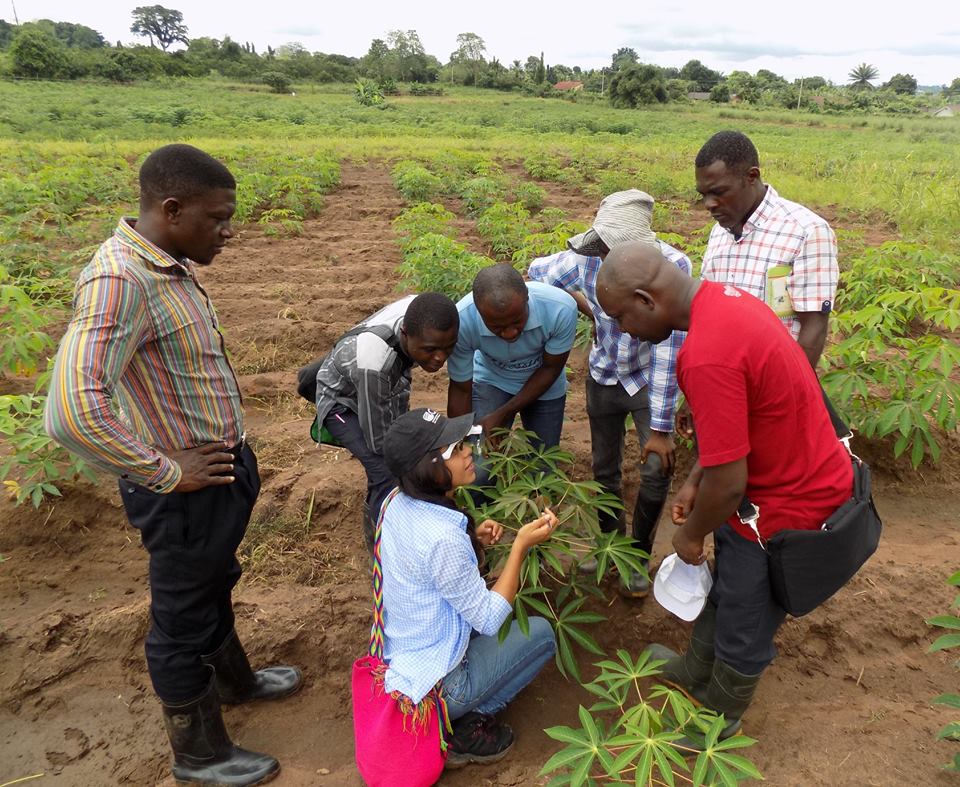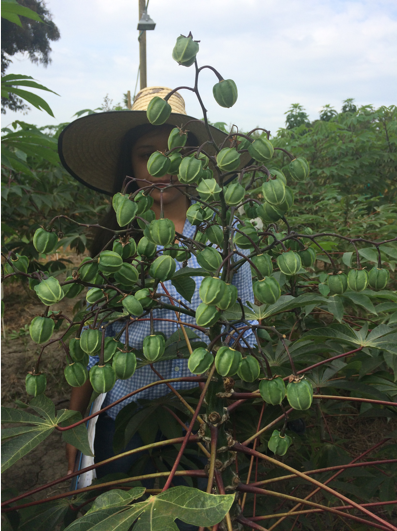The International Center for Tropical Agriculture (CIAT) works in collaboration with hundreds of partners to help developing countries make farming more competitive, profitable, and resilient through smarter, more sustainable natural resource management. They help policymakers, scientists, and farmers respond to some of the most pressing challenges of our time, including food insecurity and malnutrition, climate change, and environmental degradation. Their global research contributes to several of the United Nations’ Sustainable Development Goals, and cuts across four key themes: big data, climate-smart agriculture, ecosystem action, and sustainable food systems.
CIAT’s mission is to increase prosperity and improve human nutrition in the tropics through research-based solutions in agriculture and the environment.
CIAT joined the NextGen Cassava project in 2016, and they work with us in the following areas and more: sharing knowledge and experience in phenotyping and breeding approaches; training in conventional quantitative genetics; approaches to reduce experimental errors in trials; sharing germplasm and continuing with innovative research for the induction of flowering.

We spoke to Hernán Ceballos, Cassava Program Breeder at CIAT who has been researching cassava for over 20 years. He gave us a detailed overview of how CIAT came to participate in the NextGen project, what we have accomplished together, and what the future holds for this important collaboration.
What is CIAT’s role in NextGen Cassava?
Serendipity brought CIAT into the NextGen project. Travelling to China in 2016, we came across a new technology developed at GuangXi Subtropical Crops Research Institute to promote early fruit and seed set in cassava. CIAT was aware that NextGen was working on the induction of flowering in cassava, and therefore informed NextGen about the Chinese technology, assuming that a direct link could be established. However, it was decided that the connection should be through CIAT.
This is how CIAT eventually jumped onboard and serendipity played again an interesting role, because CIAT began working not only on the “Chinese approach” but also on other approaches led by Cornell University. So we began working with extended photoperiod and plant growth regulators. CIAT, as it turned out, is ideally located because of the experimental station’s high altitude above sea level; we think the altitude enhances the effect of extended photoperiod, that in the lower altitudes of Nigeria was not so evident. So, CIAT’s initial role was primarily in the induction of flowering work (late stages of NextGen’s Phase 1). With the second phase, however, CIAT has a wider involvement: in germplasm development (particularly introgressing resistance to whiteflies, and the recently identified immunity to cassava brown streak disease [CBSD]), and in training (in addition to the pruning technique developed by the Chinese, we offer training on statistics, conventional breeding and quantitative genetics).
What are the main activities/objectives being accomplished here?
There are many layers of activities/objectives that we wish to accomplish. I would like to emphasize the value of the culture of collaboration among many different institutions, and the relevant examples of synergies that can be accomplished through these collaborations. From my perspective, the example of the “Chinese technology” is very telling. In was in mid 2017 when the basis of the technology (pruning very young branches) became clear. By the end of that year, we were replicating the technique in Colombia with Colombian clones; a few months later, researchers at Cornell University were doing it as well, but improving the technique with the addition of plant growth regulators. So, basically within a couple of years, a technique that had been restricted to a breeding nursery in GuangXi expanded to many different programs worldwide, and in the process was improved considerably, so even GuangXi also benefited. Collaboration, trust, synergies are values that we want to emphasize.
More on the technical side, we are speeding up the process of recombination of elite cassava germplasm, making breeding more efficient. Importantly, we have a flow of germplasm not only between Latin America and Africa, as originally envisioned, but now also involving Southeast Asia as well (because of the introduction of cassava mosaic disease [CMD] into that region).
Ultimately, we want more efficient cassava breeding for better varieties that improve the livelihoods of cassava farmers in target countries of the project (but unavoidably throughout the world).
Some of our team members in Africa recently received training on flowering/pruning techniques by a team of two: Peter Hyde from Cornell (Tim Setter’s lab), and Marcela Pineda from CIAT. Can you tell us a little bit about Marcela, and what her work is focused on?
Initially, as we had a small research contract with NextGen, we hired Marcela as an assistant to do the work on photoperiod extension and the application of plant growth regulators. The results of the initial work were surprisingly good–so was the dedication and quality of data that Marcela produced! So the short-term contract was extended and the assistant became our expert on the subject. She is reliable and meticulous, and loves what she does. After two years doing the initial work, we agreed for her to leave her assistant position and become a graduate student in a Masters degree program at the National University of Colombia. Her thesis work focuses on the induction of flowering through the different strategies. As you mentioned, she has traveled to Africa together with Peter Hyde to train on the different techniques. She has a very gentle personality, and the training she does has the strength that comes with having spent thousands of hours in the field (day and night). I am sure that everyone agrees on her technical capacity, as well as her patience explaining the protocol.

Has the partnership/involvement with NextGen benefited CIAT? In what ways?
Well certainly there is a financial benefit that is really important. NextGen has been extremely important for CIAT (and the cassava community) because the project recognized that CIAT had contributions to make even for Africa. Soon after we joined the project, we had positive impacts on the induction of flowering and the identification of immunity to CBSD. We recently got the approval of a special Research Topic by Frontiers in Plant Sciences which was to be initially co-edited by Tim Setter and myself (later we added a third editor – Rodomiro Ortiz – to help us in the process). This is a good opportunity to have scientific visibility to the work we do. If enough manuscripts are submitted a book can be published.
Technically, we have had great inputs from Tim Setter’s team, which has been valuable for the progress made on the induction of flowering. It has been a remarkably productive collaboration. We are also exposed to all the other activities going on within NextGen. Having the chance, for example, to have a hot and healthy debate with Ed Buckler on how best reduce genetic load in cassava was very productive. The endless discussions with Jean-Luc on recurrent selection have been very useful for me (and hopefully for him as well); we also have constant interactions with Peter Kulakow, Robert Kawuki, Ismail Rabbi, etc. The opportunity to dream about reverse genetics with the external reviewers of NextGen is an invaluable opportunity, and a source of ideas that NextGen makes possible. When these intelligent minds meet, we exchange information and it creates the ideal conditions for new ideas to emerge.
How does NextGen fit into CIAT’s overall mission and goals?
I emphasized above the importance of this “culture of collaboration”. We are solving problems, we are creating knowledge, but we are also learning to work together in a highly complex environment, with many different institutions and very diverse perspectives and views on how to do things. Being part of NextGen helps us to widen our views and somehow soften our attitudes. We have become the global community that we should be. Certainly, NextGen is facilitating the flow of cassava germplasm from the Americas to Africa and, as stated above, we are now having unforeseen help from Africa to solve the problem of CMD in Southeast Asia. The main message here is that we are learning together.
On a very personal note, I have the privilege of interacting with young African breeders to share my experiences as a conventional breeder and quantitative genetics “expert”, and I am energized by their enthusiasm and motivation. The induction of flowering has been one of our dreams since the early 2000s when we started thinking about it with Tim Setter, long before NextGen came into the picture. That dream is now a reality which facilitate many of the specific activities and goals of the cassava breeding program at CIAT. The breeding nursery in Hawaii is a physical example of how far the collaboration between CIAT and IITA has gone, thanks to NextGen.
How do you see NextGen and CIAT’s partnership moving forward?
With any large, multi-institutional project such as NextGen Cassava, there will always be some tensions between institutions and scientists. But I believe these eventual tensions can have a positive side. What I value about NextGen is that it has proven that we can work together well, that there is space for everyone to benefit, regardless of divergences in our views on some aspects of cassava breeding. Specifically, it has been a good experience to demonstrate that American cassava germplasm and research conducted in the Americas can have a positive effect in Africa (and vice versa, of course). Perhaps for people that have been working with cassava for few years, what is happening seems natural, but NextGen (and other cassava projects supported by the Bill & Melinda Gates Foundation) are making the collaboration between many different institutions in South and North-America, Africa, Europe (and now Asia) very natural. This is indeed a breakthrough. The degree in “intimacy” between the different institutions has grown considerably, and since we now know each other much better it seems natural that collaboration in the future will be greatly facilitated.
What else is notable about CIAT?
In general, what we see is a “dilution” of the institutional identity over the years, which has a positive effect. In many ways CIAT and IITA (and many national programs) became the one big RTB program. Many of us work together on different initiatives (e.g. NextGen Cassava, African Cassava Whitefly Project, RTBfoods, etc). So, the working environment for us has evolved drastically as we maintain our institutional identity on one hand, and work on multi-institutional endeavors on the other. Since success ultimately comes from the latter, there is a healthy evolution towards team building among us.






